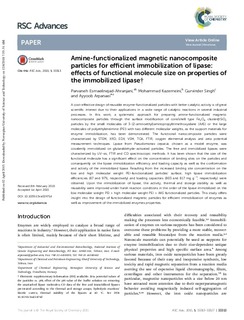| dc.contributor.author | Esmaeilnejad-Ahranjani, Parvaneh | |
| dc.contributor.author | Kazemeini, Mohammad | |
| dc.contributor.author | Singh, Gurvinder | |
| dc.contributor.author | Arpanaei, Ayyoob | |
| dc.date.accessioned | 2019-01-21T12:14:19Z | |
| dc.date.available | 2019-01-21T12:14:19Z | |
| dc.date.created | 2015-06-30T13:31:26Z | |
| dc.date.issued | 2015 | |
| dc.identifier.citation | RSC Advances. 2015, 5 (42), 33313-33327. | nb_NO |
| dc.identifier.issn | 2046-2069 | |
| dc.identifier.uri | http://hdl.handle.net/11250/2581510 | |
| dc.description.abstract | A cost-effective design of reusable enzyme-functionalized particles with better catalytic activity is of great scientific interest due to their applications in a wide range of catalytic reactions in several industrial processes. In this work, a systematic approach for preparing amine-functionalized magnetic nanocomposite particles through the surface modification of core/shell type Fe3O4 cluster@SiO2 particles by the small molecules of 3-(2-aminoethyl)aminopropyltrimethoxysilane (AAS) or the large molecules of polyethyleneimine (PEI) with two different molecular weights, as the support materials for enzyme immobilization, has been demonstrated. The functional nanocomposite particles were characterized by STEM, XRD, EDX, VSM, TGA, FTIR, oxygen elemental analysis and zeta potential measurement techniques. Lipase from Pseudomonas cepacia, chosen as a model enzyme, was covalently immobilized on glutaraldehyde-activated particles. The free and immobilized lipases were characterized by UV-vis, FTIR and CD spectroscopic methods. It has been shown that the size of the functional molecule has a significant effect on the concentration of binding sites on the particles and consequently on the lipase immobilization efficiency and loading capacity as well as the conformation and activity of the immobilized lipase. Resulting from the increased binding site concentration on the low and high molecular weight PEI-functionalized particles' surface, high lipase immobilization efficiencies (87 and 97%, respectively) and loading capacities (803 and 817 mg g−1, respectively) were obtained. Upon the immobilization of lipase, the activity, thermal and storage stability as well as reusability were improved under harsh reaction conditions in the order of the lipase immobilized on the low molecular weight PEI > high molecular weight PEI > AAS functionalized particles. This study offers insight into the design of functionalized magnetic particles for efficient immobilization of enzymes as well as improvement of the immobilized enzymes properties. | nb_NO |
| dc.language.iso | eng | nb_NO |
| dc.publisher | Royal Society of Chemistry | nb_NO |
| dc.title | Amine-functionalized magnetic nanocomposite particles for efficient immobilization of lipase: effects of functional molecule size on properties of the immobilized lipase | nb_NO |
| dc.type | Journal article | nb_NO |
| dc.type | Peer reviewed | nb_NO |
| dc.description.version | publishedVersion | nb_NO |
| dc.source.pagenumber | 33313-33327 | nb_NO |
| dc.source.volume | 5 | nb_NO |
| dc.source.journal | RSC Advances | nb_NO |
| dc.source.issue | 42 | nb_NO |
| dc.identifier.doi | 10.1039/c5ra02471d | |
| dc.identifier.cristin | 1251683 | |
| dc.relation.project | Norges forskningsråd: 197411 | nb_NO |
| dc.description.localcode | This journal is © The Royal Society of Chemistry 2015 | nb_NO |
| cristin.unitcode | 194,66,35,0 | |
| cristin.unitname | Institutt for materialteknologi | |
| cristin.ispublished | true | |
| cristin.fulltext | original | |
| cristin.qualitycode | 1 | |
